Last updated on October 23, 2023
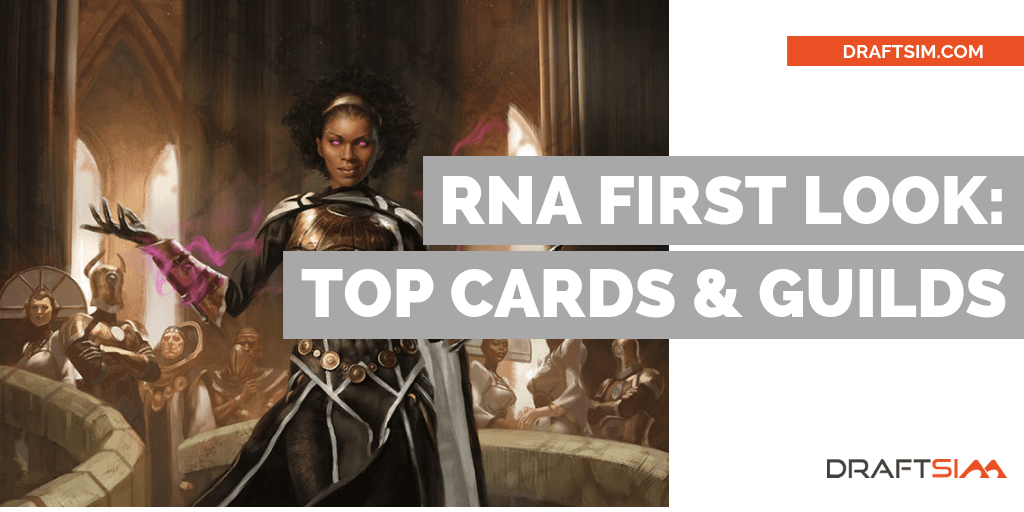
By Dan Troha and Arseny Khakhalin
I think it's safe to say that everyone had pretty similar expectations about Ravnica Allegiance going into its release — it would look very similar to Guilds of Ravnica for limited.
After all, there are five guilds, each with one mechanic. There is another cycle of CCDD cards like Nightveil Predator. A guaranteed guildgate in each pack, 24 in the whole draft. Powerful gold commons.
So does it pan out the same way? Or can the same framework lead to a different draft environment based on different mechanics or cards?
We analyzed a sample of 88,000 simulated Draftsim drafts from last week to find out. This gave our users enough time to play with the cards at the prerelease a bit and have more knowledge about interactions. For the analysis, I'll be using most of the same thought process and visualization methods from our last article. Be sure to read that one too so you can understand both sides of the story.
As for my own take on the format, I ended up practicing quite a bit in preparation for Grand Prix/MagicFest New Jersey. And I learned a heckuva lot more about the format. That said, there wasn't a ton of variety in what I drafted:
2-1 the draft at #GPNJ. 9-3 now. #theforgottenGP pic.twitter.com/EOtzUOv8Hg
— Dan Troha (@dantroha) January 27, 2019
Orzhov aggro for another 2-1 and an 11-4 finish at #GPNJ #theforgottenGP pic.twitter.com/52L4Yu6MYY
— Dan Troha (@dantroha) January 27, 2019
Personal experience aside, let's see what you all in the hive mind came up with. What's the data have to say?
Synergy
We'll start with Draftsim's signature visualization, the synergy plot. Remember that this graphic represents how often a particular card is drafted alongside another card. We introduced this visualization originally in this article.
The cards in each color cluster together because you always draft them along with cards of their own color. Cards that go together nicely will have a position that is closer to each other than cards that don't.
If we start by looking at just the shapes and colors of the visualization, you'll see that Ravnica Allegiance looks just like the Guilds of Ravnica picture. Bascially only the adjacent colors are different!
The two are fraternal twins…
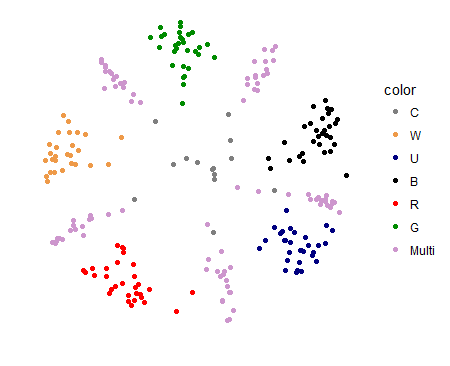
Guilds of Ravnica Synergy Plot

Ravnica Allegiance Synergy Plot
Here's a larger version of the RNA image above so you can see the definition a little better:

And that similarity makes sense. Both sets have gold cards that are only in their guild. They both have guildgates that are only in the supported guilds. The card synergies and cross color mechanics all support certain two color combinations. So everything revolves around that color dynamic.
If your reaction is still “So what, they look basically the same?”, allow me to refresh your memory about just how different M19 looked…
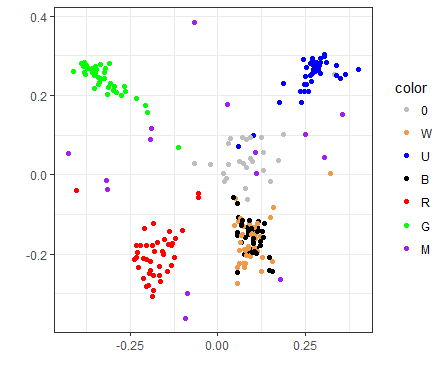
The guild-based nature of the new set creates a very strong correlation between which colors are drafted together. In a more traditional set, you don't see that kind of perfect pinwheel or “flower” shape that we see for GRN and RNA.
For all the gory details of which cards are next to which, you can click on the image below:
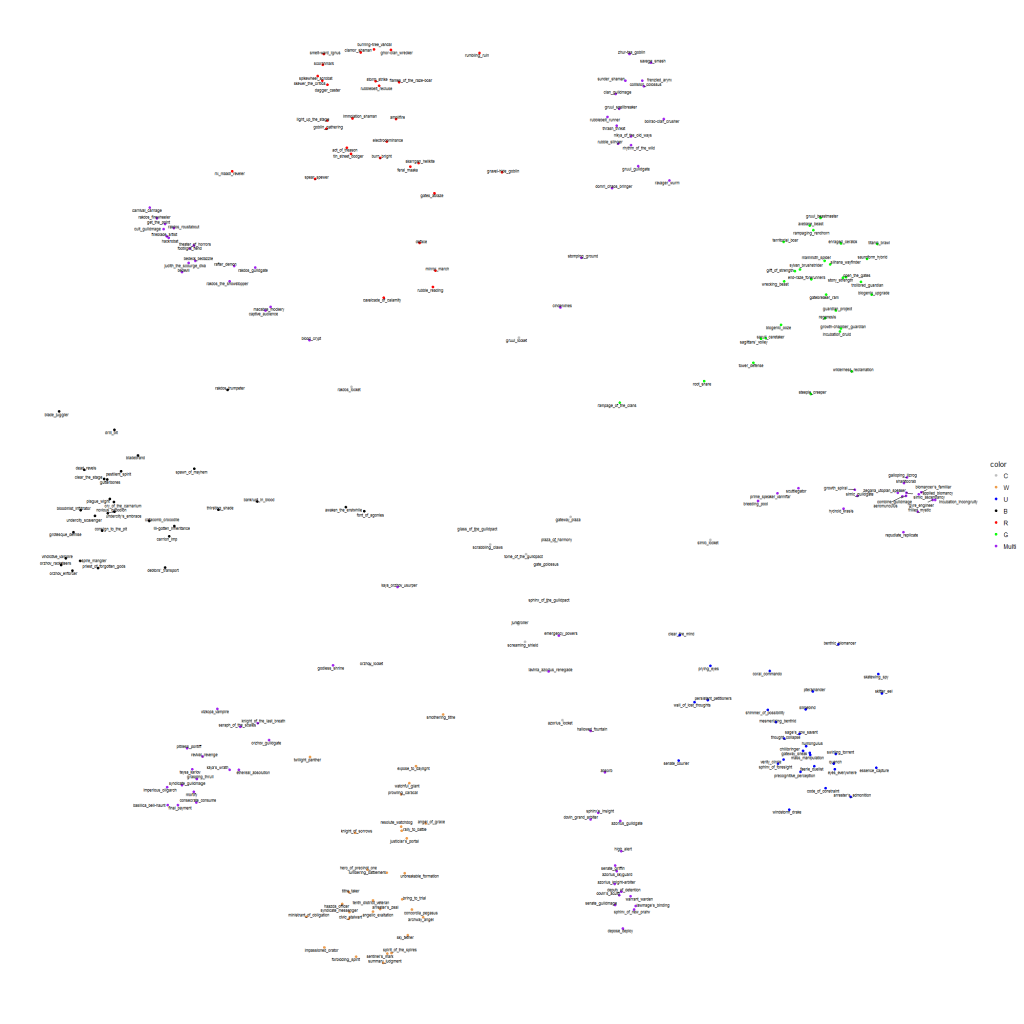
Let's take a look at the color black to get a better understanding of how synergy affects your color preference when drafting a particular card.
I decided to zoom in on the black cards that are on the left side of the visualization above.
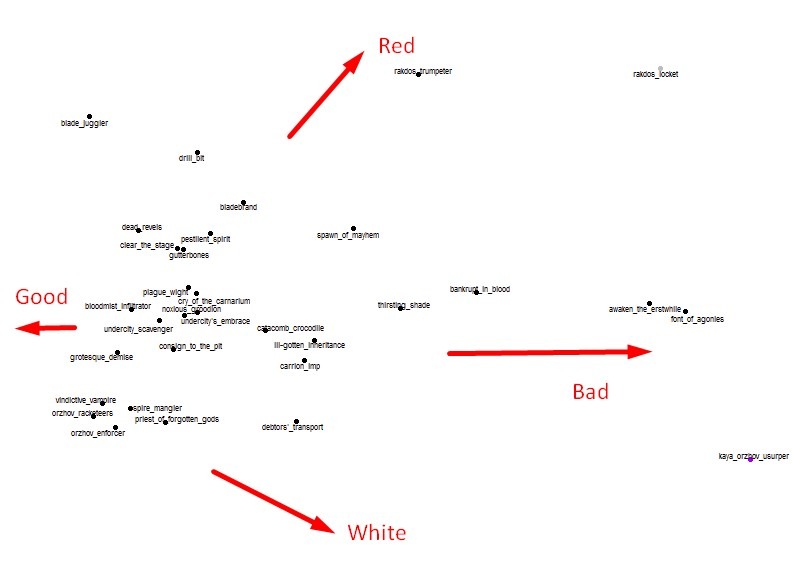
We can see a few things here:
- The generically good black cards, eg Grotesque Demise, tend to be drafted with one another. Makes sense – if you have good black cards, you want more black cards so you can build a deck.
- The generically bad cards like Font of Agonies pull towards the middle because it doesn't matter what colors you're in — you take it at the end of the pack. Picking it is almost random.
- Rakdos Trumpeter (on the top) is a special case because while it is a black card, it has a red activated ability. You are much more likely to play it in a black red deck, so hence it ends up halfway in between the two colors. Blade Juggler and Drill Bit are also strongly pulling in the red direction because red helps with enabling spectacle, which makes these cards much stronger.
- Then on the bottom of the cluster is the cards that are “more white.” This includes either things that make small creatures like Debtors' Transport or things that pay you off for small creatures like Vindictive Vampire and Spire Mangler.
Other notable outliers
Of course, color overlap and synergy can take a little bit of knowledge about the set to understand too. Blue and white have a heavy concentration of fliers. You could kind of call this Azorius's “theme” even moreso than Addendum.

And when you look at Windstorm Drake, a payoff for having flying creatures, it has sorted itself all the way to the bottom of the blue pile toward white.
Similarly, Gates Ablaze looks more like a green-red card. I think there are two reasons for this. First of all, Gruul has more big, dumb creatures that are unlikely to die if you cast a small Gates Ablaze for two. Secondly, green is often the basis for the “Gates Deck” that relies heavily on the common Open the Gates for mana fixing. So it stands to reason that a card that incentivizes you to have gates would be clustered near green.
Rumbling Ruin is also halfway to red-green. Gruul's mechanic, Riot, often places +1/+1 counters on creatures and this guy rewards you for doing just that. The “can't block” ability is even more relevant when you have a bunch of large creatures that are suddenly able to get by a bunch of small chump blockers or Gruul's biggest enemy — deathtouchers.
Color Pairs
Next up, let's take a look at the relative popularity of each color drafted. The darker a color pair is, the more popular it is:
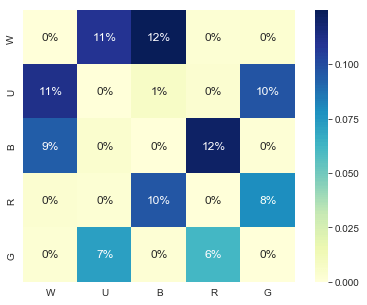
A reminder here, the x-axis represents the primary deck color — the color with the most cards drafted at the end of the draft. The y-axis represents the color with the second-highest number of cards in the drafter’s final pool.
The first thing you might notice is that just like in GRN, the off-guild color pairs aren't drafted at all! There are just too many powerful on-color guild cards to ignore the guilds altogether.
So our most popular guilds ended up being Rakdos (22%), Azorius (22%) and Orzhov (21%) with Simic (17%) and Gruul bringing up the rear at 14%. This certainly resonates with my experience online and in person.
If I had to guess, I'd wager that the strength of black is related to the strength of its commons. Grotesque Demise, Blade Juggler, Dead Revels, and Ill-Gotten Inheritance are all pretty exciting Magic cards at common. And the next best cards after them are quite solid as well. The relative depth and power level of the black commons could be one explanation for why its guilds are so popular.
Unfortunately, this analysis does not take into account three color decks. From what I've seen so far, many many decks in RNA are composed of two colors with a splash or some that are straight 3-5 colors. It might be a good opportunity to try and capture fully completed decks in the future so we have more information about a deck's final configuration.
The guild color wheel – a new visualization
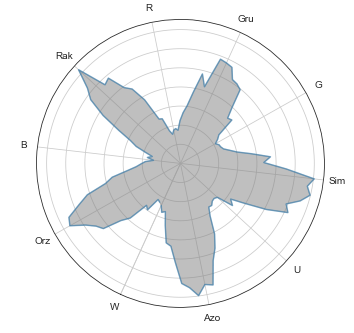
On the topic of three-plus color builds, we were curious if some guilds or colors are more “dense” and encourage players to commit to a narrow strategy, compared to other guilds or colors that would encourage reaching out to neighboring guilds.
What if, say, Gruul worked better when combined with another guild, but Simic worked better as a narrow Simic-only build?
To quantify this stuff, Arseny created a “Guild Color Wheel,” ordered with the colors in adjacent guild order (W/U/G/R/B) for RNA. He encoded these colors as angles, with muliticolored (guild) cards assigned angles between the “pure” angles.
For example, you could code white as 0, blue as 1, and Azorius cards as 0.5. Then you calculate the average “angle” of each pool/deck, and the “angular breadth” of each deck. Most decks lie directly on the “guild petal” for their respective guild because they are largely made up of cards from the guild's two colors.
The longer the petal is, the more popular that color pair.
While I think this looks really cool, it doesn't look very edgy or revelatory. Still, you can observe how relatively unpopular Gruul is because its peak is shorter than the other guilds. This is just a different way to represent the data in the previous tile visualization.
You can also see that some petals are slightly skewed from the “average guild” because one of the two colors provides more cards to support an archetype. Simic is slightly skewed towards blue. Azorius is skewed towards white. But nothing too dramatic.
We can actually estimate the popularity of three-color decks with this plot as well! Picture a W/U/G deck with an equal number of white and green cards. Both those colors would pull the graph equally away from the color in the middle of them — blue. You can see the popularity of the three color decks then by looking at the notches in the center of each of the five colors.

Orzhov/Rakdos (“B) is deep and narrow. The deepest point lies 1.5 steps from the center of the plot. On the other hand, Azorius/Simic (“U”) is wide and shallow, and the deepest point is 2.7 steps from the center. This suggests that Azorius/Simic is 80% more popular than Rakdos/Orzhov.
This seems like it could make sense because Rakdos skews more aggressive (less time to splash stuff), whereas Simic has cards that both can ramp and fix mana.
Top Cards
Next up, let's take a look at the top cards in the set. What did you all love the most? And who is the villain? The worst of the worst?
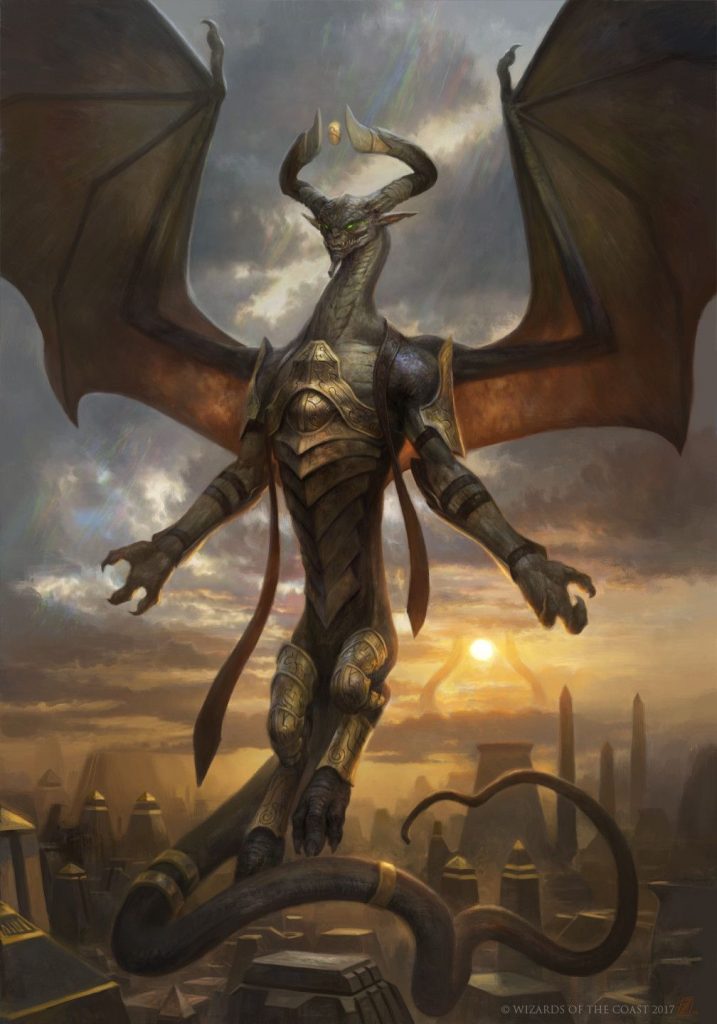
This metric was calculated by simply noting the pick number for which each card was selected and then averaging it over the number of times it was picked.
Rares and mythics
| Card | Average Pick Number |
| Skarrgan Hellkite | 1 |
| Spawn of Mayhem | 1 |
| Angel of Grace | 1 |
| Thrash | 1.000887 |
| Mesmerizing Benthid | 1.001304 |
| End-Raze Forerunners | 1.001604 |
| Biogenic Ooze | 1.00222 |
| Warrant | 1.00394 |
| Incubation Druid | 1.004773 |
| Electrodominance | 1.005469 |
These are all very powerful rares, and I think most of them deserve their place in the upper echelon. In fact, many of them are right at the top of my own tier list for Draftsim.
The most suspect inclusion might be End-Raze Forerunners, which I think is a very good and powerful card, but I certainly overrated how easy it would be to cast. You can't just put an 8-drop into any green deck. Particularly when Gruul is asking you to be playing threats much earlier and there is a good tempo-oriented build of Simic.
Commons and uncommons
| Card | Average Pick Number |
| Trollbred Guardian | 1.488131 |
| Flames of the Raze-Boar | 1.503823 |
| Grotesque Demise | 1.62925 |
| Mortify | 1.636954 |
| Skewer the Critics | 1.802282 |
| Incubation | 1.987985 |
| Summary Judgment | 2.196741 |
| Essence Capture | 2.436544 |
| Ministrant of Obligation | 2.653157 |
| Depose | 2.726859 |
Mostly what we see here is a couple of very efficient creatures and some of the better removal in the set.
Incubation // Incongruity is particularly surprising given its power level — good but not insane. I understand the flexibility of the split cards and know that hybrid mana makes them higher picks. However, I definitely would hope to see Consecrate // Consume and Collision // Colossus on a list of top picks.
The 10 “worst” cards
| Card | Average Pick Number |
| Clear the Mind | 11.9236 |
| Rakdos Locket | 11.88896 |
| Rubble Reading | 11.87844 |
| Gruul Locket | 11.75127 |
| Orzhov Locket | 11.71442 |
| Azorius Locket | 11.61988 |
| Deface | 11.61142 |
| Root Snare | 11.55006 |
| Simic Locket | 11.53424 |
| Expose to Daylight | 11.30305 |
It's funny how the context of these cards in the format has changed already. We seem to have more people than ever drafting each set right out of the gate. Between Arena, Magic Online, and paper, every nook and cranny and niche strategy in a format is being explored almost as soon as players can get their hands on the cards.
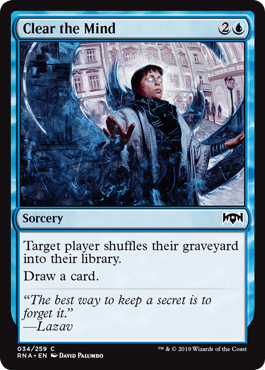
Clear the Mind is an excellent example. At first, it looks completely unplayable — it basically does nothing! Especially in a set without very many graveyard synergies or payoffs, it looks like a card that has no reason to exist. I wouldn't blame anyone for ignoring it early on in a draft format.
But what if you have a control deck with a million removal spells and no win conditions? Or what if you're going all in on Dovin's Acuity? On a recent episode of the Lords of Limited podcast, the hosts outlined a deck where you really need to have one or two copies of Clear the Mind. It's definitely not a card you should ever be prioritizing, but it does play a critical role in a deck that will sometimes come up.
Also, lockets are much better in Ravnica Allegiance than they were in Guilds. Many of the people I talked to at the GP were happy to run one or even two in a draft deck. I kept hearing the format is “grindy” and there “isn't much aggro.”

Finally, I think Expose to Daylight is criminally underrated here. There are so many ubiquitous powerful, game-changing enchantments in RNA that you have to answer. Angelic Exaltation, High Alert, Ill-Gotten Inheritance, and the biggest baddy of all, Ethereal Absolution, just to name a few. And that's not not even considering incidental Lawmage's Bindings, Sky Tethers, and Slimebinds out of Azorius.
So the lesson here is that people's expectations are heavily influenced by previous sets. I would expect to see many of these pick averages go higher as the format matures.
Controversial Cards
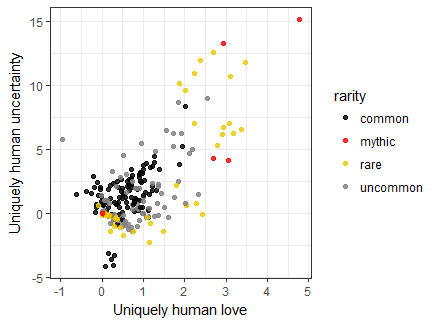
In short, “controversy” means “variance in pick order.” The more disagreement people have about where in the pack a card should be picked, the more controversial it is.
For a more in-depth look at the controversy calculation method, check out the previous analysis article.
Most controversial cards overall
Last time, we had a lot of “weird rares” take the prize for most controversial card. What about for RNA?
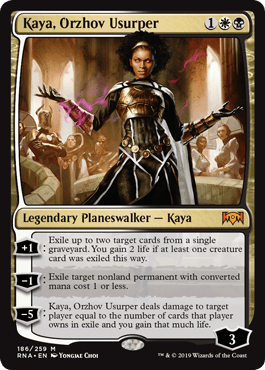
1. Kaya, Orzhov Usurper
2. Emergency Powers
3. Cindervines
4 Font of Agonies
5. Smothering Tithe
6. Rampage of the Clans
7. Mirror March
8. Awaken the Erstwhile
9. Lavinia, Azorius Renegade
10. Wall of Lost Thoughts
Yep, that certainly appears to be the case again. And most of these cards are actively “bad,” not just weird. But they have a high complexity level and strange applications, which makes them perfect for confusing people. It stands to reason that our drafters would evaluate the cards very differently.
So why is Kaya such a HUGE outlier?
I think planeswalkers are generally insane bombs. In fact, many of them have been nigh-unbeatable when resolved because usually the only way to interact with them in limited is by having a board presence and attacking them.
But Kaya doesn't do much at all. There are very few relevant 1 mana permanents to exile. And exiling creatures from graveyards is barely relevant. And what's the payoff? What kind of ultimate is she threatening?
So I think some people took the card highly assuming “you have to take planeswalkers when you open them” or exercising a little “simulated raredrafting.” But others realized she doesn't have many applications in a game of limited.
Maybe the card is going to be great in Modern or Legacy, but it's definitely not in draft.
Most controversial commons
Looking at commons can help us understand synergy and set context dependent cards that people value differently.
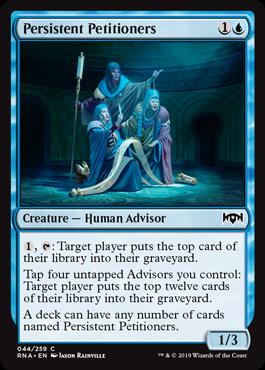
1. Persistent Petitioners
2. Spear Spewer
3. Rakdos Trumpeter
4. Simic Locket
5. Gravel-Hide Goblin
6. Goblin Gathering
7. Thirsting Shade
8. Azorius Locket
9. Senate Courier
10. Saruli Caretaker
It's interesting that we have three of the off color activation creatures on here — Rakdos Trumpeter, Gravel-Hide Goblin, and Senate Courier. This is another class of card that looked a little underwhelming at first but it turned out that each has just enough of what you really want to do in its respective guild (trigger spectacle, two drop, blocker with high toughness) to be highly sought after.
I think the most fun example here is Goblin Gathering. I would say that “high variance in pick number” is probably the optimal way to draft this card.
Say you pick up your first copy – you probably shouldn't prioritize it because one copy is pretty low power. You take it 10th pick. Then you pick up your next one a little higher. And by the time you get to 4-5 copies you might want to first or second pick the card because each additional copy is just so much better.
So depending on what stage you're in during the draft and how many copies you have, the pick priority fluctuates wildly. You could also say that for the #1 common Persistent Petitioners. However, copies 1-4 are all still pretty underwhelming…
I would be remiss not to mention my own pick for most controversial common — or at least the most talked about — Ill-Gotten Inheritance. Good ol' IGI finished at #11 on our controversy rankings. This was a very difficult card to evaluate and while some initial opinions on the card were that it was “unplayable,” things have swung in the other direction and it may be well on the road to becoming overrated.
For a very interesting analysis on just how good this card is, check out Ari Lax's article from his blog.
Wrapping Up
So we still have a lot to learn. After all, this format has only been out a couple weeks and there's much left to explore. Most of the guilds have multiple sub-archetypes, plus there are all these three color and gates-matter decks.
But I would recommend a few things based on the data above: First off, start by drafting a bomb mono colored or hybrid card (duh). Flexibility is key in draft, and there's a reason those cards were unanimous, slam dunk first picks.
I really like the most popular guilds of Orzhov, Azorius, and Rakdos. But all the guilds are playable and people are winning drafts with all five of them. So start your draft by taking powerful cards that can go in multiple guilds or be splashed, then move into the open guild (or gate deck…).
While I had a preference to draft Orzhov at the Grand Prix last weekend, that preference didn't outweigh the necessity to stay open. You'll win in this set by being set up to play as many powerful gold cards as you can get.
Finally, take a good look at the most controversial cards and make sure you understand why they are either good or bad. They're likely to be the most confusing to evaluate if you have to decide how good the card is the moment you open a booster. This list is a great place to start if you want to chat with your friends or people at your store about their experiences with weird cards.
And that'll do it for today! Good luck in any drafts you've got coming up — may you build some incredibly spicy and awesome limited brews.
If you enjoyed this article, be sure to sign up for our mailing list to be notified when we publish new articles like this one or release new sets on the site to draft!
[mc4wp_form id=”318″]
Follow Draftsim for awesome articles and set updates: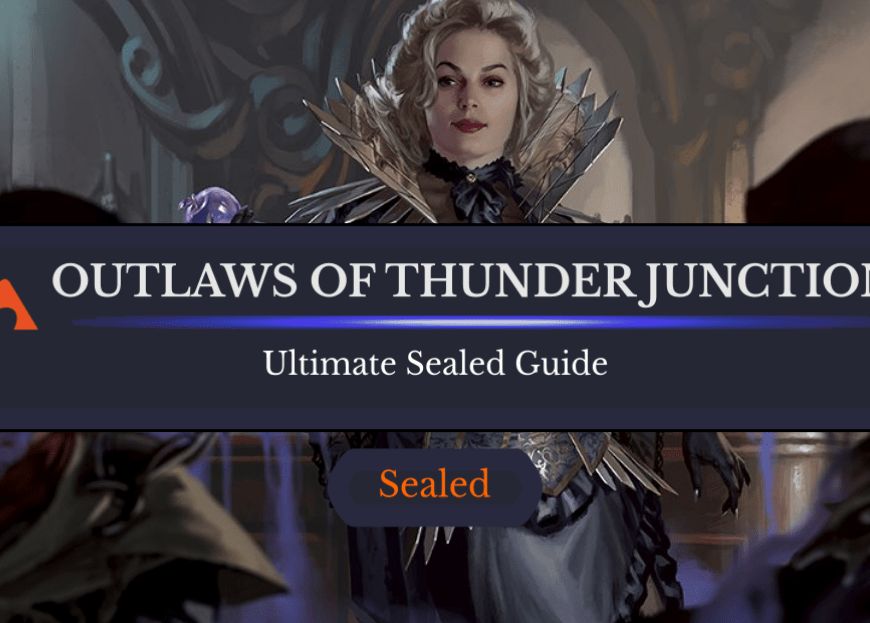

4 Comments
A lot of your links point to cards in different series.
Please do more coverage of three+ colored decks. It’s obvious that the gold colors have the most affinity. Eg, if I’m in simic what other colors should I consider drafting and which specific cards?
Also, what 2-3 card combos should I look for? Druid and that green card that untaps and adds a +1/+1 counter is a stock combo to unleash druids 3 mana ability
I think you can actually infer a lot of this information from the synergy plot with all the cards labeled. For example, if a card is in between both colors of Simic, but it is pulled in the direction of another guild, that is an indicator that it might prefer to be paired with another particular color. Same goes for 2-3 card synergies within the same color — that should be reflected on the synergy visualization by the cards being close together.
I personally think people are underrating Kaya. Her +1 ability essentially wrecks Drake and Arclight/Rekindling Phoenix. I personally believe she is a cheap buffer against those kinds of decks provided you can survive the game long enough.
That may be true, but this article is about limited, not constructed 🙂
Add Comment